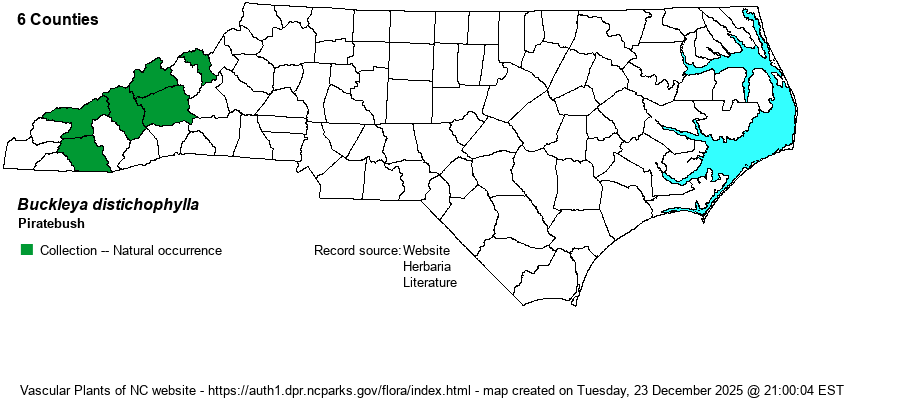| Author | (Nuttall) Torrey | |
| Distribution | Mountains only, mainly in the southern mountains, from Madison and Buncombe counties southward, but an isolated record from Mitchell County. It does not occur in the Blue Ridge, but in mountain ranges to the west, several close to the TN border. Though it occurs in the several VA counties along the NC border, occurrences in NC counties nearby (Ashe and Alleghany) are not likely due to poor habitat for the species there.
This is a southern Appalachian endemic with a limited range. It is found in barely 20 counties, from southwestern VA to southwestern NC, and also in eastern TN, including a disjunct population in the Cumberland Mountains of TN. It is not known from KY, SC, or GA.
| |
| Abundance | Rare in the state, and quite restricted in habitat. It is a State Threatened species. | |
| Habitat | This unique species (though there are four other Buckleya species in Asia) grows only on dry bluffs or other steep slopes, often where rocky or there is loose soil. It usually grows under pines or at times under hemlock species, but it also is found in pine-oak/heath stands. Many sites are precarious to reach owing to steep conditions or to rocky or loose gravelly soil. A few decades ago, this root-parasite shrub was thought to be parasitic only on the roots of hemlocks, especially the scarce Tsuga caroliniana. Such is not the case, though it seems to be parasitic mainly on conifers, especially pines. | |
| Phenology | Blooms in April and May, and fruits in August. | |
| Identification | This is a strange-looking deciduous shrub that is fairly tall, reaching an average height of 8-12 feet tall. It looks like a shrub with pinnately-compound, distichous (all in a single plane) leaves, such as an elderberry (Sambucus), or a sapling such as an ash (Fraxinus) or hickory (Carya). However, this “pinnate leaf” is actually a stem with about 6 “pairs” of essentially opposite elliptical leaves (averaging 1.5-2 inches long) that are larger toward the tip, presenting a “top-heavy” look to the stem and its leaves. Thus, Buckleya stands out like a “sore thumb” in its dry, rocky bluff/slope habitats. The flowers -– males on one plant and females on another (as the species is dioecious) -- are small and greenish and seldom draw attention, though the nearly 1-inch long fruit (a drupe) at the end of a twig, always seeming to dangle downward, does catch the eye if you are lucky enough to see it in fruit. | |
| Taxonomic Comments | None
| |
| Other Common Name(s) | Sometimes simply called Buckleya for a common name. | |
| State Rank | S2 | |
| Global Rank | G3 | |
| State Status | T | |
| US Status | | |
| USACE-agcp | | |
| USACE-emp | | |

